You might be wondering what customer segmentation is all about and whether it’s something you really need to bother about.
Well, firstly let me ask you this: “Do you speak to your mum the same way you speak to your best friend of 20 years?”
No, I didn’t think so. And the same can be applied when it comes to speaking to your customers.
You’ll have a bunch of different customer types, each with unique pain points and expectations from your business. And you’ll have to find a way to communicate with each of these in a way that resonates with them.
However, despite the many wonders of automation, it’s almost impossible to speak to every single one of your customers individually in a way that is scalable and time-efficient.
This is where customer segmentation can come into play. It’s an extremely powerful tool (more stats on that later) that can help you speak to customers in a way that makes sense to them.
So, in this blog, we’re going to explore what customer segmentation is, and why it’s so important to integrate it into your customer journey.

Understand exactly what customer segmentation is...
Step one lies in understanding exactly what customer segmentation is.
And to be honest, it’s such a difficult thing to talk about in general terms, purely due to the fact that it’s so bespoke to every single business (despite what Google might have you believe).
However, essentially customer segmentation is the process of dividing your potential and existing customers (or audience) by certain criteria in order to personalise their experience.
Customer segmentation is the process of dividing your potential and existing customers into groups that are similar in specific ways. #customersegmentation #customerjourney
Segmentation is implemented via tags, lists and custom fields (in email marketing or on your website), however exactly what information you collect and how you segment will be relative to your marketing efforts.
It’s all about making sure that you are helping your audience in the best way possible, and so you need to know what information it’s essential that you collect in order to better help and segment them.
But the one thing that we can agree on is that your segmentation should be in aid of increasing the likelihood of someone purchasing from you, or in relation to improving the experience of something they have already purchased
No matter how you choose to segment your customers, you’ll need to split them into smaller groups with similar characteristics relative to your overall marketing goals. This will allow you to target and communicate with them in a more focused manner, and in a way that resonates with them.
And that really is segmentation in a nutshell, but that doesn’t really help you do it now does it?
So, let's try and help you with that...
Related content: The 13 types of customers and how to behaviourally segment them.
Criteria for segmenting customers…
You’ll remember that I said it’s hard to speak about segmentation in really general terms, as it’s something that is so specific to each individual business.
Remember our definition: Customer segmentation is the process of dividing your potential and existing customers by certain criteria in order to personalise their experience.
And it’s these criteria that make the development of segmentation systems so bespoke.
Every single company will have different criteria that they want to slice their audience up into and this will need to align with their business goals.
However, people are routinely segmented using different factors:
Exactly how you segment these customers will be relative to your marketing efforts. However, people are routinely segmented using factors such as:
- Age
- Gender
- Personality
- Interests
- Income
- Spending habits
What are the different types of segmentation...
To understand a little more about how you can segment and why you might choose to segment that way, let’s look at the different types of segmentation in a little more detail.
Behavioural: tracking people's behaviour to learn more about them, what they might be interested in and utilising that to help us provide them with more accurate information.
Lead Type: A really classic example might be marketing qualified vs. sales qualified. Or you might split leads up into what service they are interested in i.e. copywriting.
Customer type: Are they a new customer, a loyal customer. Were they a previous lapsed customer, and if so what did they buy?
Engagement Level: This is where I like to get fancy, i.e. what type of lead magnet did they download, how long has it been since they last opened an email or engaged in a campaign?
System/Reporting: Where someone has been on your site, why they have been there. You might want to measure certain KPIs.
When you are beginning to think about segmentation strategies, you should be thinking about them in these types of terms. Think about what type of information you need to know in order to help segment customers into these groups.
An example of engagement segmentation in action is via one of our clients. They track engagement via email campaigns, and this allows them to run a re-engagement campaign every two months for subscribers who are not engaged. This allows them to increase engagement by 2.5-3% every two months, which might not seem like a lot but has the potential to increase sales dramatically.
If you aren’t already, it’s useful to track behaviour and start grouping the audience to help you with the segmentation process.
So, this is why I (sadly) can’t just give you a blog on how to segment your customers - as it will be so different for every business.
However, hopefully, this has helped you outline your own segmentation strategy, so that you can start on the segmentation journey.
Why is it important to segment your customers?
Meridith Hill said it best: “When you speak to everyone you speak to no one.”
No one likes being spoken to like they are the same as everyone else - we like to feel special. And this is why customer segmentation is so crucial. You can’t treat all your customers and potential customers the same.
However, it is virtually impossible to speak to every single customer in a unique and fully personalised way.
By segmenting you are acknowledging and understanding that every customer is different and making an effort to target specific, smaller groups with marketing messages that resonate with them.
What are the benefits of this….
Benefits of segmenting your customers...
With automation and marketing in general, the goal should be to build relationships with your audience.
Implemented correctly, customer segmentation is a very powerful tool and it allows you to learn about your customers on a deeper level so that you can build relationships and tailor communication to their unique paint points.
This will allow you to:
- Create targeted campaigns
- Improve customer service
- Improve customer retention
- Increase the customer lifetime value
- Communicate via customer-preferred channels
And if you don’t believe how powerful customer segmentation can be, just take a look at these stats...
A survey from Mailchimp found that campaigns using segmented groups had open rates of 14.32% higher than non-segmented campaigns, and a 101% increase in click-through rates.
In addition, McKinsey conducted a study that showed that retailers using segmentation saw a 3-5% increase in returns when they ran promotions.
Pretty amazing statistics...
Ultimately, successful customer segmentation will allow you to communicate with each of your potential and existing customers in the most effective way and increase sales, and improve customer retention.
Related content: Customer Lifetime Value: Where do your profits really come from?

Need help with customer segmentation?
You might be thinking: ‘this sounds great...but I still have no idea where to start.’
If this sounds like you then don’t worry, we can help you out with engagement and segmentation strategies as part of our project offerings.
Get in touch to discuss how we can work together to make sure you are segmenting like a total champ!


